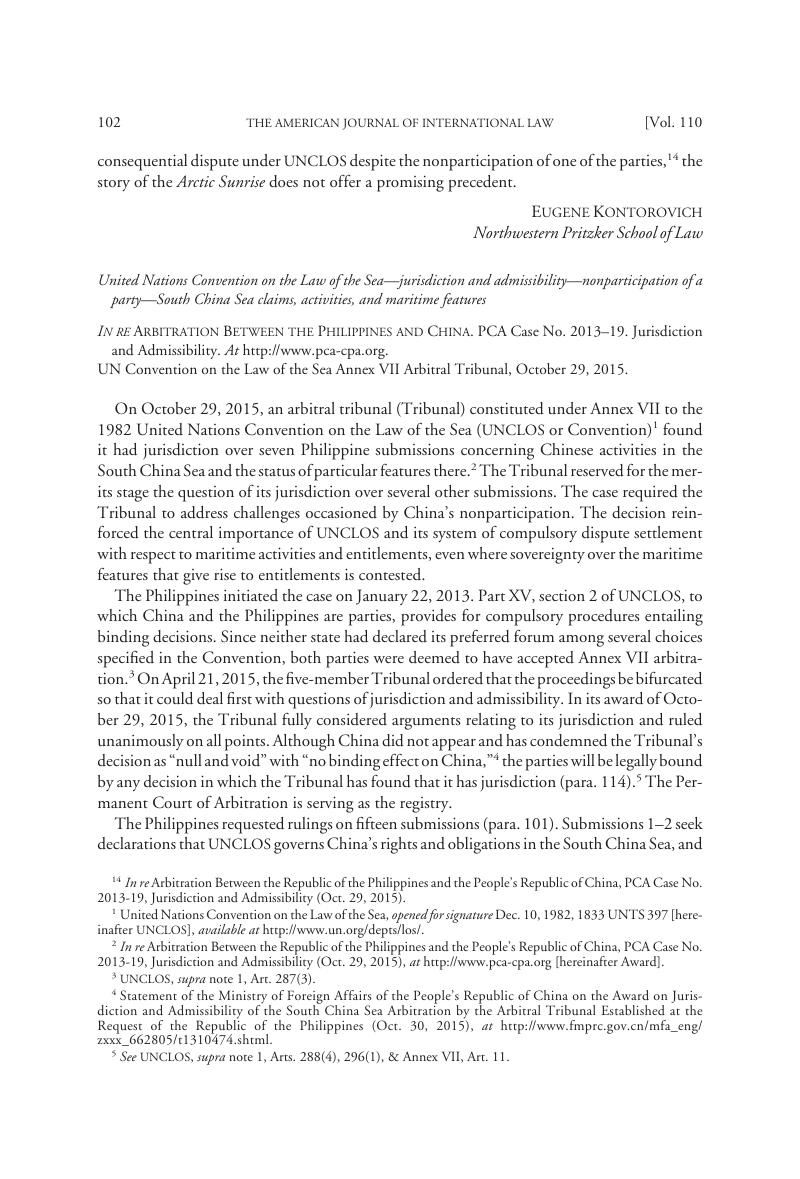Article contents
In re Arbitration Between the Philippines and China
Published online by Cambridge University Press: 20 January 2017
Abstract

- Type
- International Decisions
- Information
- Copyright
- Copyright © American Society of International Law 2016
References
1 United Nations Convention on the Law of the Sea, opened for signature Dec. 10, 1982, 1833 UNTS 397 [hereinafter UNCLOS], available at http://www.un.org/depts/los/.
2 In re Arbitration Between the Republic of the Philippines and the People’s Republic of China, PCA Case No. 2013-19, Jurisdiction and Admissibility (Oct. 29, 2015), at http://www.pca-cpa.org [hereinafter Award].
3 UNCLOS, supra note 1, Art. 287(3).
4 Statement of the Ministry of Foreign Affairs of the People’s Republic of China on the Award on Jurisdiction and Admissibility of the South China Sea Arbitration by the Arbitral Tribunal Established at the Request of the Republic of the Philippines (Oct. 30, 2015), at http://www.fmprc.gov.cn/mfa_eng/zxxx_662805/t1310474.shtml.
5 See UNCLOS, supra note 1, Arts. 288(4), 296(1), & Annex VII, Art. 11.
6 China first officially published this line in a government atlas in 1948. Gao, Zhiguo & Jia, Bing Bing, The Nine-Dash Line in the South China Sea: History, Status, and Implications, 107 AJIL 98, 103 (2013)CrossRefGoogle Scholar. For maps showing the line, see Permanent Mission of the People’s Republic of China to the UN Secretary-General, Note Verbale CML/17/2009 (May 7, 2009), at http://www.un.org/depts/los/clcs_new/submissions_files/mysvnm33_09/chn_2009re_mys_vnm_e.pdf; 107 AJIL 96 (2013). The precise legal significance of this line has been unclear. See U.S. Dep’t of State, Limits in the Seas, No. 143, China: Maritime Claims in the South China Sea (2014), at http://www.state.gov/documents/organization/234936.pdf; Dupuy, Florian & Dupuy, Pierre-Marie, A Legal Analysis of China’s Historic Rights Claim in the South China Sea, 107 AJIL 124 (2013)CrossRefGoogle Scholar; Gao & Jia, supra.
7 The Philippines has since amended submission 15. Hearing on the Merits and Remaining Issues of Jurisdiction, Day 4, at 204–05, In re Arbitration Between the Philippines and China [Philippines/China] (Nov. 30, 2015), at http://www.pcacases.com/web/sendAttach/1550 (asking the Tribunal to rule that “China shall respect the rights and freedoms of the Philippines under the Convention, shall comply with its duties under the Convention, including those relevant to the protection and preservation of the marine environment in the South China Sea, and shall exercise its rights and freedoms in the South China Sea with due regard to those of the Philippines under the Convention”). According to the hearing transcript, the Philippines also amended submissions 2, 11, and 14. See id. at 201–04.
8 Quoting UNCLOS, supra note 1, Annex VII, Art. 9; Rules of Procedure, Art. 25(1), Philippines/China, at http://www.pcacases.com/web/view/7.
9 Position Paper of the Government of the People’s Republic of China on the Matter of Jurisdiction in the South China Sea Arbitration Initiated by the Republic of the Philippines (Dec. 7, 2014), at http://www.fmprc.gov.cn/mfa_eng/zxxx_662805/t1217147.shtml [hereinafter China, Position Paper]. Academic commentators have also argued that the Tribunal lacked jurisdiction. See, e.g., The South China Sea Arbitration: A Chinese Perspective (Stefan Talmon & Bing Bing Jia eds., 2014); Yee, Sienho, The South China Sea Arbitration (The Philippines v. China): Potential Jurisdictional Obstacles or Objections, 13 Chinese J. Int’l L. 663 (2014)CrossRefGoogle Scholar.
10 See also Award, paras. 68, 380–83.
11 On other issues, the Tribunal found that “the Philippines’ act of initiating this arbitration did not constitute an abuse of process.” Id., para. 413(C); see also id., paras. 124 –28. Furthermore, “there is no indispensable party whose absence deprives the Tribunal of jurisdiction,” id., para. 413(D), because no rights of third states formed the subject matter of the decision and the lawfulness of third states’ conduct was not at issue, id., para. 181.
12 2002 Declaration on the Conduct of Parties in the South China Sea, para. 4 (Nov. 4, 2002), at http://cil.nus.edu.sg/2009/cil-documents-database/ (Search ASEAN Documents; enter keyword “South China Sea”).
13 Quoting Southern Bluefin Tuna (NZ v. Japan; Austl. v. Japan), Jurisdiction and Admissibility, 23 R.I.A.A. 1, 43, para. 57 (UNCLOS Annex VII Arb. Trib. 2000).
14 The Tribunal evaluated the application of Article 281 to a series of bilateral statements from 1995 to 2011; the Treaty of Amity and Cooperation in Southeast Asia, opened for signature Feb. 24, 1976, 1025 UNTS 319; and the Convention on Biological Diversity, opened for signature June 5, 1992, 1760 UNTS 79. See Award, paras. 230–89.
15 Article 282 would have barred such recourse if the parties had agreed elsewhere that their dispute “shall, at the request of any party to the dispute, be submitted to a procedure that entails a binding decision,” but the parties had not so agreed. Award, para. 413(E); see id., paras. 290 –321. In addition, because China and the Philippines had exchanged views regarding the means of settling their disputes, they had met the requirements of Article 283. Id., para. 413(F); see id., paras. 322– 43.
16 For maps showing Scarborough Shoal and the remaining South China Sea features mentioned in this report, respectively, see Award, figs. 3 & 4, at 7 & 9.
17 Emphasis omitted.
18 UNCLOS, supra note 1, Art. 298(1)(a)(i); see China, Declaration Under Article 298 (Aug. 25, 2006), in UN Division for Ocean Affairs and the Law of the Sea, Declarations and Statements, at http://www.un.org/depts/los/convention_agreements/convention_declarations.htm. Articles 15, 74, and 83 concern delimitation of maritime boundaries of, respectively, the territorial sea, the EEZ, and the continental shelf.
19 China, Position Paper, supra note 9, para. 68.
20 See also Award, paras. 154, 172.
21 At the hearings on the merits, much of the argument regarding submission 5 concerned whether Itu Aba and Thitu, both claimed by China and both within 200 nautical miles of Mischief Reef, were, as the Philippines contended, Article 121(3) rocks entitled only to a 12-nautical-mile territorial sea.
22 See also Award, para. 107.
23 Joint Separate Opinion of Judge Wolfrum and Judge Kelly, para. 6, Arctic Sunrise (Neth. v. Russ.), ITLOS Case No. 22, Provisional Measures Order of Nov. 22, 2013, at http://www.itlos.org.
- 2
- Cited by




